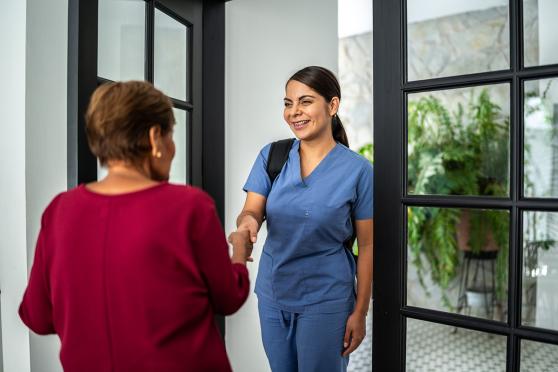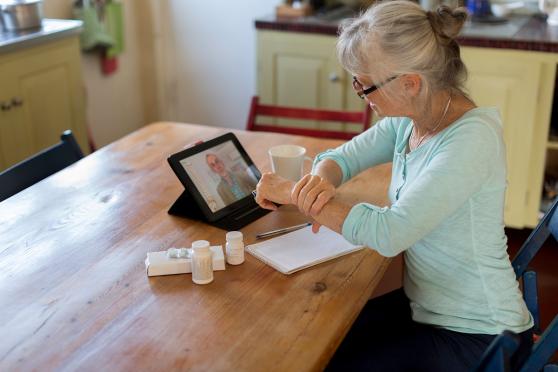How to prepare for your Matrix in-home health assessment

To get the most out of this comprehensive appointment, it’s a good idea to learn more about how an in-home health assessment works and how you can prepare for it.
The information in this article is for educational purposes only and is not intended to replace medical advice from your doctor.
It’s been more than a century since house calls were the norm, so it’s understandable if you’re not sure what to expect from your upcoming health and wellness assessment. This type of appointment means that a Matrix Medical Network clinician will come into your home and perform a series of tests to see how you’re doing. Matrix virtual health assessments, which take place via video chat, may also be an option for you. These appointments are designed to make taking charge of your health as easy as possible for you.
To help make this appointment run smoothly, we’ll explain how an in-home health assessment works and how you can be ready to make the most of it.
What you can expect
Unlike an office visit where you may see a doctor for less than 20 minutes, a Matrix in-home health assessment gives you up to a full hour of undivided attention with a trained clinician. Most of the time, that person is a nurse practitioner. During this time, the clinician will:
- Give a physical exam and ask about any new concerns
- Review all the medications you take
- Diagnose new health issues and recommend treatment, or give you a referral to a specialist
- Screen for depression, hypertension, cognitive problems, and more, depending on your risk factors and insurance coverage
- Educate you about any health problems you may have
- Help you properly use home health devices, such as finger-prick tests, inhalers, or blood pressure cuffs
- Answer your health questions
- Share personalized recommendations to help you reach your health goals
How you can prepare
The checklist below will help you prepare and minimize the chances of forgetting something that you want to discuss.
1. Write down all of your questions.
If you have any concerns that you want to talk about — from minor aches to bigger issues such as recurring headaches or chest pain — jot them down on a notepad or on your mobile phone. This way, you’ll have them ready during your at-home assessment.
If you’re not sure where to start, it can be helpful to think about your health goals. Maybe you want to lose weight, reverse your diabetes, or get off blood pressure medication. Or you may have multiple relatives who all had strokes and you want to learn how to decrease your risk. Whatever your goals, write them down and ask your clinician about them.
“The provider is there to help you reach those goals and create a plan to do so,” says Ashley Bannon, DNP, FNP-BC. She is the clinical manager of the Northeast region for Matrix Medical Network in Hope Valley, Rhode Island.
2. Answer your pre-visit call.
On the day or evening before your at-home health assessment, you will receive a phone call to confirm the appointment. Try not to let that call go to voicemail. They are calling to give you the specific time the clinician expects to arrive, so you can be at home and ready to see them.
3. Gather all your medications.
It can be hard to keep all your medication straight, especially if you have prescriptions from multiple doctors. Gather the bottles for every medicine you take — including supplements and over-the-counter medications — so that the Matrix clinician can review them. If necessary, they can explain what each one does, how and when you should take them (such as with or without food), and look for any negative interactions between them.
4. Take your shoes off.
Part of your at-home assessment is a foot exam, so be prepared in advance to have them checked out. “It can take some people a surprisingly long time to take their shoes and socks off,” says Bannon. So, she suggests you either go barefoot or wear slippers or sandals you can easily slide off.
5. Drink some water.
Many times, a home assessment includes a urine test. The clinician will call when they’re on their way, so it’s a good idea to drink a glass of water right after you hang up. That gives your bladder time to fill and makes the test go faster.
6. Have your primary care doctor’s contact information on hand.
At the end of the at-home health assessment, the clinician will send a summary to your primary care provider (PCP). This way, your PCP can see what you discussed, all the medications you’re on, and if any other health problems have popped up since your last visit with them.
Most of the time, people benefit from following up with their PCP. The clinician can even help you book your appointment — and, if necessary, help connect you with transportation services for you to get there.
The clinicians are looking forward to being a partner in your care. Taking these simple steps ahead of time will help ensure you get the most out of your visit.



